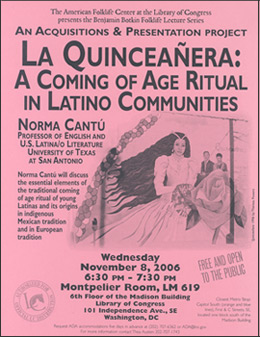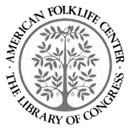| |
|||
|
The American Folklife Center at the Library of Congress
|

|
When a young Latina turns 14, she starts dreaming of her quinceañera, the coming of age ritual that will mark her transition into adulthood in her community. Her immediate and extended family will soon be involved in the preparation—reserving a dance hall, a mass at the local parish, ordering the dress, and recruiting “sponsors” for the various aspects of the celebration.
The celebration includes a number of cultural practices that cement the social bonds among the participants. Perhaps the most essential of these is the custom of having “sponsors” — or “madrinas” and “padrinos” — whose charge is to provide the essential items that will mark the transition from childhood to adulthood. The celebration occurs in a religious and social setting and incorporates site-appropriate elements. Thus, there are “sponsors” for items worn by the young woman — the dress, the tiara, the shoes, jewelry (such as bracelet, ring, watch, earrings) — and for items like the dance music, the church, the cake, and the brindis, or toast.
From a feminist perspective, the celebration offers ample room for analysis of the ways that the feminine is performed, as well as what it means to be an adult woman. The celebration marks a threshold in the life of a young person, and a transition between two social positions occurs. At one part of the celebration, this transition is symbolically marked as the young woman removes her flat shoes and dons high heels. In a culture whose gender-stratified expectations limit a young woman’s world, she is now given more freedom. The conundrum is that as the young woman is now presented to society as a “marriageable” woman, a fifteen-year-old is still a child according to U.S. law.
The celebration has become a central life-marker celebration along the line of weddings, baptisms and confirmations, although everyone recognizes that it is not a sacrament. Indeed, although it originated among Catholics, it is not limited to those communities today; the tradition exists even in Baptist or Methodist congregations. And the expansion of the celebration into non-Catholic realms is not the only change it has undergone. As all traditions, with the passage of time, new elements are added and old ones discarded. The quinceañera has undergone significant changes; for example, while traditionally it was restricted to female celebrants, it is now not unusual to have quinceañeros, that is, fifteen-year-old males, celebrate in similar fashion.
Specific questions that have emerged as I have studied this particular cultural practice are, on a very elementary level, the following: What are the essential elements of the celebration? What are its origins in indigenous Mexican tradition and in European tradition? What are the components that define it as a coming of age ritual? How does the performance of the feminine play out in the celebration? A more theoretical exploration asks: How do border theory and mestizaje theory apply to this particular event? How is the seemingly non-feminist event foster feminist views? And finally, taking a long-range view, how will the celebration develop into the next fifty years?
Norma E. Cantú Norma E. Cantú currently serves as Professor of English at the University of Texas at San Antonio. She received her Ph.D. from the University of Nebraska — Lincoln. She is the editor of a book series, Rio Grande/Rio Bravo: Borderlands Culture and Tradition, at Texas A&M University Press and is a member of the Board of Trustees of the American Folklife Center at the Library of Congress. Author of the award-winning Canícula: Snapshots of a Girlhood en la frontera, and co-editor of Chicana Traditions: Continuity and Change, she has just finished a novel, Cabañuelas and is currently working on another novel tentatively titled: Champú, or Hair Matters, and an ethnography of the Matachines de la Santa Cruz, a religious dance drama from Laredo, Texas.
 The American Folklife Center was created by Congress in 1976 and placed at the Library of Congress to "preserve and present American Folklife" through programs of research, documentation, archival preservation, reference service, live performance, exhibition, public programs, and training. The Center includes the American Folklife Center Archive of folk culture, which was established in 1928 and is now one of the largest collections of ethnographic material from the United States and around the world. Please visit our web site.
The American Folklife Center was created by Congress in 1976 and placed at the Library of Congress to "preserve and present American Folklife" through programs of research, documentation, archival preservation, reference service, live performance, exhibition, public programs, and training. The Center includes the American Folklife Center Archive of folk culture, which was established in 1928 and is now one of the largest collections of ethnographic material from the United States and around the world. Please visit our web site.
| ||||
